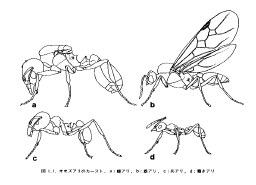Ants can usually by divided into three castes: worker, female (= queen) and male. These three castes can easily be distinguished from each other on the basis of external appearances. However, the details of the castes of ants involved in reproduction (e.g., the queen caste and the male caste) have not yet been fully clarified for all species of ants.
 Worker(d): The worker has no wings. It shows marked fusion or devolution of the thoracic regions. The metanotum has disappeared in the worker. The worker can be regarded as being female in terms of gender. However, since the reproductive organs (ovaries, etc.) have degenerated, the worker is traditionally distinguished from the egg-laying female (queen, a). The sizes of workers often vary among different species or genera. Workers with large heads, which are visibly different from the smaller workers, are called soldiers(c). Identification of some species of ants is difficult unless soldiers are used for identification.
Worker(d): The worker has no wings. It shows marked fusion or devolution of the thoracic regions. The metanotum has disappeared in the worker. The worker can be regarded as being female in terms of gender. However, since the reproductive organs (ovaries, etc.) have degenerated, the worker is traditionally distinguished from the egg-laying female (queen, a). The sizes of workers often vary among different species or genera. Workers with large heads, which are visibly different from the smaller workers, are called soldiers(c). Identification of some species of ants is difficult unless soldiers are used for identification.
Female, queen (a): The egg-laying female resembles the workers, except that she has ocelli on her head and that her thorax morphologically differs from that of the worker. The female has wings on her thorax. For this reason, the mesonotum is well developed in the female, even after the wings have fallen off. The metanotum is also evident in the female.
Male (b): As compared to the female and the worker, the male can be characterized by: (1) well-developed compound eyes and ocelli, (2) the antenna composed of many segments, and (3) short scapes and a degenerated mandible. The thorax has developed in the male as well as in the female. The features used by the identification key to characterize individual species or genera are often not applicable to the identification of males. (Comment by Kazuo Ogata)




